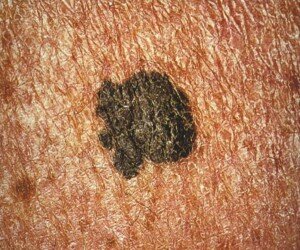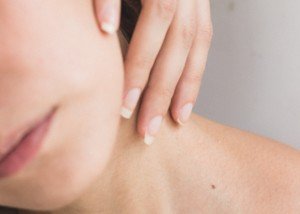
Unfortunately, among all those blackheads on your nose, chin or cheeks could be a very early melanoma slyly blending in and going unnoticed.
If the new “blackhead” begins developing in an isolated area on your face, away from other blackheads, it’s more likely to be noticed and then surveilled.
Melanoma “can start as a small black dot that to an untrained eye could resemble a blackhead,” says Sharyn Laughlin, MD, board certified dermatologist and co-founder of the DermaEnvy Skincare ™ line of sun protection products and medical director of Laserderm, a pioneering laser skin surgery clinic in Ottawa, Ontario, Canada.
“It will not yield to squeezing — since most people cannot resist squeezing. This black dot will evolve and change along the ABCDE rules on melanoma.”

Melanoma. CDC, Carl Washington, MD, Emory Univ. School of Medicine, Mona Saraiya, MD, MPH
Blackheads, as you surely already know, don’t visibly progress beyond the appearance of a tiny black dot.
A melanoma in their midst will, over time, begin to stand out as it grows.
This doesn’t mean you should obsessively inspect every blackhead on your face.
But keep an eye on any that stand out, such as a new tiny dot that’s not part of your usual cluster of blackheads.
ABCDE Melanoma Rules
The new little black dot isn’t necessarily melanoma if it’s not a blackhead.
It could be the beginning of an age spot or lentigo, a seborrheic keratosis, a clogged pore or a new benign mole – even if you’re middle aged or older.
New spots or “blackheads” that look like moles, however, should be examined by a dermatologist.
Chances are they’re benign, but a new spot in middle age is more likely to be a melanoma when compared to new moles in young adulthood.
 In practice for 30+ years, Dr. Laughlin has been lead or co-investigator in many research trials and an innovator in developing new laser technology. dermaenvy.com.
In practice for 30+ years, Dr. Laughlin has been lead or co-investigator in many research trials and an innovator in developing new laser technology. dermaenvy.com.
 Lorra Garrick has been covering medical, fitness and cybersecurity topics for many years, having written thousands of articles for print magazines and websites, including as a ghostwriter. She’s also a former ACE-certified personal trainer.
Lorra Garrick has been covering medical, fitness and cybersecurity topics for many years, having written thousands of articles for print magazines and websites, including as a ghostwriter. She’s also a former ACE-certified personal trainer.
.


























